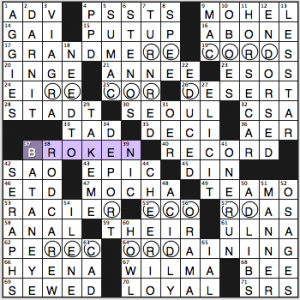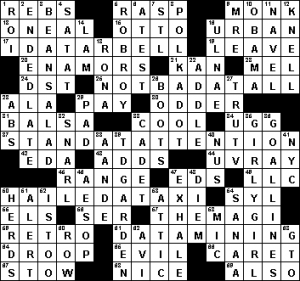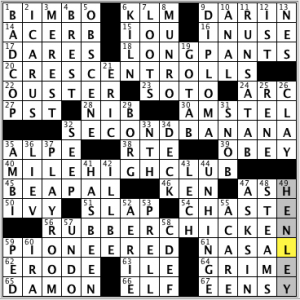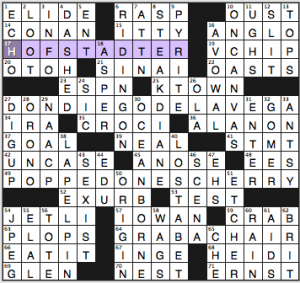AV Club 5:24 (Amy)
NYT 4:23 (Amy)
LAT 4:28 (Gareth)
CS 11:38 (Ade)
Daniel Landman’s New York Times crossword
The theme involves splitting a key word across multiple answers in the grid, so it plays like a puzzle with 12 theme squares since you needn’t pay any attention to those split answers in order to solve the puzzle. Not the most satisfying sort of theme for me.
37a, 40a. [With 40-Across, repeat offender? … or something found, literally, in four rows in this puzzle], BROKEN / RECORD. The word RECORD is broken across answers and I’ve circled its four broken appearances in my grid. The places where the word is hidden don’t bring the excitement, as it involves fill like EIRE, COR., RDAS, and PEREC. There’s also the perfectly good prefix ECO with that always-mystifying clue, 55a. [Car starter?]. Still don’t know anyone who talks about “ecocars,” and I drive a Hybrid and know an electric driver.
Lots of fill had a decades-old vibe to it—at least it did where I started in the puzzle, with PPD and STENOS and the Graf SPEE. And elsewhere, HORSECAR and -O-RAMA. And then there are the abbreviations (ADV, COR, CSA, ETD, plural and outdated RDAS, plural SRS, PPD), the awkward plural (PSSTS), various fragments and partials (GAI, A BONE, DECI-, AER, SAO, ECO-, SPEE, -O-RAMA, -IAL). And, if you prefer English vocab, there are also four foreign entries (ANNEE, ESOS, STADT, TE AMO). Lest you think I am being too hard on the constructor, see what he says at Wordplay: “Almost immediately after I mailed this puzzle in, about a year ago, I experienced a severe case of constructor’s remorse; I regretting submitting a puzzle with so much short ugliness and crosswordese, especially in the ‘theme rows’ (all of my more recent puzzles are cleaner than this). But when I was notified that the puzzle was accepted, it was very instructive: Will didn’t comment at all on the bad fill, but rather on how he liked some of the long Downs.” Memo to Will: That Gorski puzzle you singled out as having four junky answers edited out along with DELPY? This grid has a heckuva lot more junk in it, and BAT AN EYE/CHEERIO weren’t nearly enough to make me overlook the dross.
I do like seeing ILENE in the grid (54d. [Chaiken who co-created “The L Word”]), as my best friend’s mom spells her name the same way (and female creators/showrunners are still underrepresented in Hollywood).
2.75 stars from me.
C.C. Burnikel’s Los Angeles Times crossword – Gareth’s review
Today’s theme is [NSA surveillance activity … or, the process needed to dig out the info hidden in 17-, 25-, 37- and 50-Across?], DATAMINING. Somewhat controversial bringing the NSA into the clue? Anyway, the other four long across answers have DATA hidden in them. Two use a central AT to facilitate this. Two don’t. For better or worse, three of the four are phrases of more than two words. We have:
- [Progressive Era muckraker], IDATARBELL. Personally, I know her only from crosswords.
- [“Pretty darn good”], NOTBADATALL

- [Assume a military posture], STANDATATTENTION. Somewhat awkward clue. Interestingly, this is the only reason I can see that the puzzle is 16×15.
- [Waved from the curb, perhaps], HAILEDATAXI
Other remarks:
- [Kevin’s “A Fish Called Wanda” role], OTTO. Does anyone really remember the names of film characters like that? Obviously some like RHETT are memorable, but personally I don’t feel like most have much of a life outside of the film.
- [With 26-Down, fashionable footwear], UGG + BOOTS. They’re still fashionable? Maybe they’re [In again], RETRO?
- [Balthazar, Caspar, and Melchior], THEMAGI. These names don’t appear in most canon places that talk about THEMAGI. Those places also don’t specify that there were three, although they bring three gifts.
- [Vegetarian side], BEANSALAD. Insert obligatory, “but what is it now?” remark here.
- [Field fare, briefly], MRE. I remember this as “mystery”.
- [Unlikely tomboy], GIRLYGIRL. I’d have thought the stereotypes are more than unlikely – mutually exclusive, but I’m willing to be persuaded otherwise.
- [Boston Bruins’ home], TDGARDEN. New to me, but looks like a solid, fresh answer.
3.5 Stars
Gareth
Tony Orbach’s CrosSynergy/Washington Post crossword, “City Dining”—Ade’s write-up
Hello once again, everybody!
Welcome to Hump Day, and I hope that you all enjoyed today’s puzzle, brought to us by Mr. Tony Orbach. Each of the four theme answers are phrases/nouns in which the first part of the entry is also the first part of certain city nicknames. The second parts of the entries are also types of food, and the clues to the entries are puns, playing off of the food angle.
- CRESCENT ROLLS: (20A: [Official bread of New Orleans?])
- SECOND BANANA: (32A: [Official fruit of Chicago?])
- MILE-HIGH CLUB: (40A: [Official triple decker sandwich of Denver?])
- RUBBER CHICKEN: (56A: [Official joke dish of Akron?])
I’m pretty sure my parents flew KLM once back in the 70’s or ’80s, since I always remembered seeing ID tags strewn around my apartment when growing up (6A: [Airline to Amsterdam]). I also think I was responsible for littering those tags around the house as well. For some reason, the intersection of BE A PAL (45A: [“C’mon, bud, help me out here”]) and I’LL BE stuck out, and it struck me as somewhat amusing (42D: [“My word”]). Person 1: Be a pal, won’t you? Person 2: I’ll be! Also liked the intersection between RUBBER CHICKEN and PLAYROOM, as all playrooms across the country should be equipped with at least one rubber chicken (37D: [Toy-filled place]). I once heard a bad pun involving BREST (4D: [Port in Western France]). One time, when the French soccer team in the city, Stade Brestois (simply known as Brest), were losing and descending down the French soccer standings, I heard one reporter say, when Brest moved down in the standings after a loss put them in 12th place, that “Brest…sag to twelfth.” Remind me never to use bad puns when I’m on the air, ok?!
“Sports will make you smarter” moment of the day: SOTO (23A: [____ speak]) – I always remember watching former Cincinnati Reds pitcher Mario SOTO play in the 1980s, but I definitely caught him in the later part of the ’80s, meaning I missed the best part of his Major League career. I was totally shocked to find out that between 1980 and 1985, Soto struck out 1,063 batters, more than any other pitcher in baseball during that six-year span.
Thank you so much for the time, and I’ll see you all on Thursday!
Take care!
Ade/AOK
Byron Walden’s American Values Club crossword, “Hidden Genius”
17a. [Pulitzer Prize-winner Douglas whose three famous subjects are hidden in this puzzle’s theme answers] clues HOFSTADTER. He wrote the book Gödel, Escher, Bach, and those three names appear in these:
- 27a. [Zorro’s secret identity], DON DIEGO DE LA VEGA. We’ve lost the umlaut.
- 49a. [Experienced something for the first time, so to speak], POPPED ONE’S CHERRY.
- 64a. [“Go ahead, sit”], “GRAB A CHAIR.”
All right, that works. “Grab a chair” isn’t a dictionary-grade phrase but I’ve heard it and possibly said it.
Five more things:
- 25a. [Manhattan neighborhood with lots of kimchee and karaoke, familiarly], K-TOWN. Didn’t know Manhattan had a K-Town. Fresh fill.
- 71a: Jodi ERNST and the 57a: IOWANs she represents make for a very fresh combo, 8 days old.
- 11d. [Dyspeptic sounds], UGHS. So Byron meant the Rex Parker sort of dyspepsia and not the too-much-crappy-food sort that leads to URPS, my first answer here. Question: Would URP pass muster as crossword fill? Because I use the word plenty but a lot of dictionaries don’t record the word; this one does, but not with my meaning (urpiness is generally shy of out-and-out burps, in my book).
- 43d. [Glass ceiling fan?], SEXIST. Ha! Good clue.
- 44d. [Butler’s domain?], EDU. As in Butler University’s website.
3.9 stars. EES, ORONO, A NOSE, and OLA knock this one below 4.




As between clean fill and interesting themes, constructors and reviewers seem always to prefer the former. But I imagine most solvers prefer the latter–especially where, as here, what damages the fill is not obscurity but partials and abbreviations that may be guessed as easily as current words and phrases. I liked this puzzle, for the elaborate theme and the long Downs. The fill just didn’t bother me.
Most solvers don’t know there is a theme, so no.
I’ve read the assertion that most solvers don’t even know there is a theme many times on the blogs. Where is the evidence for this assertion?
Ben, I believe it’s from anecdotal evidence. New crossword blog commenters sometimes remark that they didn’t know there were themes before they started reading the blog. After the documentary “Wordplay” came out, a number of viewers said they hadn’t known there were themes. And hardcore solvers or constructors have had conversations with people who had no idea there were themes.
I usually jump to solving without paying much attention to the theme. I’ll take a step back and look at the entire puzzle when I am well into it. No shock – it can be very useful. Today it saved me the embarrassment of complaining about the ILENE/PEREC crossing when I realized I needed a REC to go with the ORD from 64a.
My pushback today comes from cluing STOW as Store in LAT. That caused an audible groan. And not in the pleasurable pun sense.
Deb Amlen doesn’t keep hard stats, but says “quite a few” of the folks who attend her talks/classes on crosswords are in the dark on themes. Also, Gareth’s mom seldom notices the themes in the puzzles her son makes.
Thanks, Amy. I feel like it could be a bit of a leap to say that the majority of solvers don’t know about themes, but maybe I am being naive. It seems to me that many themes are impossible not to notice. But I don’t know why we can’t have both clean fill and interesting themes; one seems to preclude the other only in the cases where a grid has an overabundance of theme content.
Hell, some of us expert solvers, although we know there are themes, do not take the time to notice what those themes are when actually solving. (Guilty.)
True enough. There have been many times when I’ve only appreciated the theme after looking at the completed grid. But I feel like someone who has to struggle a little bit to complete a puzzle would have more chance of piecing together the theme as a necessary element of their solve than someone who is doing a puzzle in a couple of minutes.
In a perfect world, we get clean fill, clever themes, everything good, all the time. We don’t live in such a world. Why can’t we endure some questionable fill for the sake of a good theme?
As to solvers not noticing themes, I have some equally good anecdotal evidence of my own: the people I know notice them, including my own dear mother.
But whatever the habits of people we know, or of people who people we know know, if we want to argue that most solvers don’t notice themes, what state of mind must we impute to these solvers when they read a clue like this: “With 40-Across, repeat offender? … or something found, literally, in four rows in this puzzle”? How can anyone read a clue like this, and not wonder what’s going on in the said four rows? Such wondering is all that’s involved in noticing a theme.
I liked the NYT a lot! I’d never heard of “The L Word”, so I looked it up… GRANDMERE to me evoked the very old lady with whose family I lived in Paris — she rarely said anything except her constant admonition “Eteignez, mes infants!” (Turn off the lights.) Also, I thought the MOHEL was spelled Moyle, so I googled and discovered the latter is a rare breed of horse: Moyle horses often have small frontal skull bosses, referred to as “horns” on their foreheads, a trait seen only in a very few breeds, such as the Carthusian horse of Spain. Brightened my day!
Hey,
I agree with the criticism that the NYT has too much junky fill, but I liked the theme idea. Problem with such themes is that, like themes with lots of triple-checked letters, they add difficulty to the constrution without decreasing word count. If a theme has four 12-15 letter entries, then the rest of the fill can involve a lot of short words and still stay at or below 78 words total. If, however, the theme entries involve a lot of shorter words, the constructor is compelled to have more long entries elsewhere to keep the total word count down, and that runs into things like PSSTS and ABONE. I am not defending crud, but I do recognize that the constructor was trying to do something more difficult than it might have at first appeared. Did he succeed? That’s in the eye of the beholder.
Well exactly. Clean fill is nice. Interesting themes are nice. There is, or should be, no rule that the latter is always sacrificed in behalf of the former.
Theme preferences are also in the eye of the beholder. “Oh, look, the letters in that word are also in those other places” doesn’t capture my fancy the way something amusing does, or the way a particularly nice wordplay find does.
True. As between fill and themes in reviews, maybe fill has the advantage, because there’s no disputing that “ESNE” doesn’t appear much in the world, that “PSST” isn’t normally a noun that takes a plural, whereas a theme I find delightfully clever someone else can easily and plausibly condemn as simple-minded. In fact, reviewers who indulge in such condemnation can congratulate themselves on having more sophisticated minds than those slovenly constructors or their witless admirers–or Will Shortz. (I don’t mean the reviewers on this site .) It’s easy to pick apart fill, that is, but hard to evaluate themes.
AVCXword, which is only blogged about here, was a tough one this week. 67 minutes for me. NE corner was 30 minutes alone. I ended with one error: ANGLe/TePS. I get ANGLO OK (fatigue had set in) but perhaps someone can explain how TOPS is [Some porn specialists]. Thanks.
In gay porn, tops are the givers and bottoms are the receivers, intercoursally speaking.
I’m impressed by the range of your erudition, Amy
As they would say in gay porn, Amy’s versatile.
NYT: for what it’s worth, two of the columns also have very broken “record”s in them: ROD CAREW and HORSECAR/ADLIB.
I sort of figured out what themes are, but am not sure what “clean fill” means. Can someone enlighten me?
Clean fill is what you see in every Patrick Berry puzzle—words that we know (with difficulty coming from the clues). Words that aren’t made by adding junky affixes (e.g., RE-, -ER, -NESS, -S) to make unfamiliar forms of real words (PSSTS is an example of that here). Very few partial phrases that can’t stand alone (OR I). No surfeit of abbreviations, no clunky abbreviations we seldom see (AFTS for afternoons, e.g.). Names that can’t be clued without resorting to horribly obscure references. Broadly familiar vocabulary and not the stuff that dwells in crosswords far out of proportion to their use in the rest of the newspaper (ERNE, ERSE, ERLE, OGEE, OISE, ODER) solely because they contain common letters.
Aha. Thxs.
Every Patrick Berry Puzzle? I join wholeheartedly in Amy’s admiration of Berry’s work, but a simple search of this six-word list at xwordinfo.com shows that, in the New York Times, Berry used “ERLE” twice (May 10, 2009, March 26, 2006), “OGEE” on May 3, 2008, and “OISE” on January 12, 2003. My point is that we don’t inhabit a crossword-perfect world: even the greatest of us must stoop, on rare occasions, to necessity. So let’s admire clever themes, as well as snarl at bad fill.
I sure wish you’d comment with some version of your real name and email address. Can’t help wondering if you’re someone I know, just hiding your identity.
I’ll bet you $50 that those Berry puzzles with ERLE, OGEE, and OISE did not include 10 or 20 other junky entries. I bet the number was quite low (and I also suspect that all of his post-2010 puzzles are smoother than that 2003 one, as many constructors’ standards have risen in recent years).
I won’t take this bet. I’m sure you’re right about the Berry puzzles. You’re also right that today’s puzzle had more junk fill than is usual, and more than would ever appear in a Berry puzzle. I grant all that readily. My point, which I still adhere to, is that some dubious fill, in the service of an intricate and demanding theme, is perfectly tolerable. And as to this puzzle, I admired the theme ever so much more than I resented the fill.
I’m no one you know; but I’ll email you my address.
Since you don’t have “Like” buttons here, I feel like saying that I agreed with everything that 7d5a9b1 said today, and liked some of Bencoe’s comments too. I had fun with the NYT today, using the theme to help me finish the puzzle.